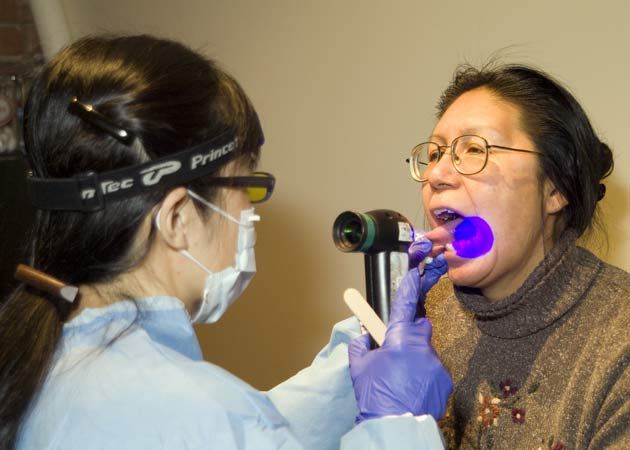Fancy Flashlight to Help Find Oral Cancer

A hand-held light may soon help dentists and physicians find oral cancer faster and more reliably.
That's important because in America alone each year 30,000 people are diagnosed with oral cancer and only half of them will survive more than five years, according to the National Institute of Dental and Craniofacial Research. And people who do survive oral cancer may do so at the cost of painful and disfiguring surgery, as chunks of tongue, jaw or palate are carved from the patient's mouth.
The problem, says Miriam Rosin, a cancer biologist at the British Columbia Cancer Research Center in Vancouver, Canada, is not only that dentists and general practitioners don't do frequent enough inspections, but when they do they usually inspect the mouth under ordinary light.
Ordinary light doesn't highlight what has turned out to be a reliable indicator of some cells' health: their natural fluorescence. In the right environment, specifically under a specialized blue light, cells can flash their condition like a lighthouse warning of a submerged reef.
This new device, called a Visually Enhanced Lesion Scope, or "VELScope," (combined with program of regular oral checkups, Rosin cautions) could reveal early evidence of the fast-spreading disease, which is most common in smokers and heavy drinkers.
Used correctly the device can spotlight cells that have turned to the dark side, literally, as well as those that are teetering on becoming cancerous.
"You shine a blue light on the tissue and it excites fluorophores in the tissue to release fluorescence of a specific wavelength," Rosin explains. "It looks green, because we have filters in the system, and what we're looking for is the loss of that green color."
Sign up for the Live Science daily newsletter now
Get the world’s most fascinating discoveries delivered straight to your inbox.
When viewed through an eyepiece attached to the light source, healthy cells shine pale green. But abnormal, potentially cancerous "dysplastic" cells look dark green to black.
Dark cells don't necessarily equal cancerous cells, she says, but a biopsy would be a wise next step. In fact, when Rosin's group shined the VELScope into 44 mouths, healthy cells were correctly distinguished from abnormal cells for 43 of the patients. In these tests the scientists were able to detect all of the patients who did not have abnormal cells in a specific test site and were able to detect cancerous conditions with 98-percent confidence.
This research was published in the March/April issue of the Journal of Biomedical Optics. Other scientists are developing similar devices to hunt down cervical cancer and lung cancer.
- Gold Probes Could Reveal Cancer in Your Body
- Cancer Takes Over Top Spot as Killer of Americans Under 85
- Caffeine Free: Blue Light Makes People Alert at Night












